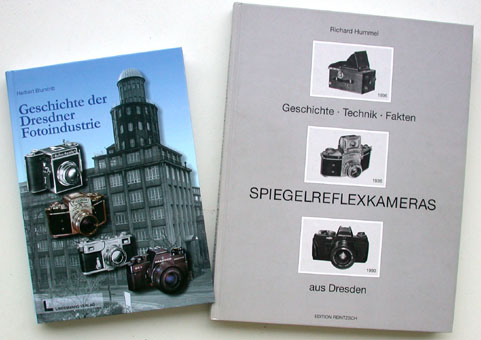The history of the KW
1919 – 1959
The birthplace of the Praktica
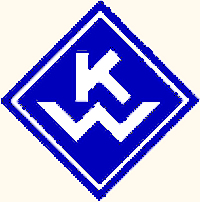
1919
Paul Guthe and Benno Thorsch establish the: Kamera-Werkstaetten Guthe & Thorsch Zinzendorfstrasse 48, Dresden A1 The company has great succes with the very flat “Patent-Etui” folding camera.
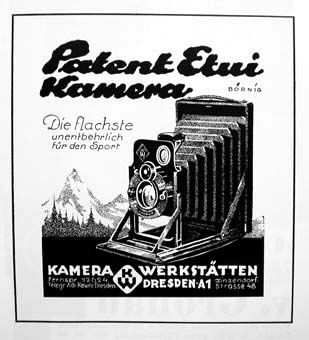 1928
1928
The company needs more space and moves to Baerensteiner Strasse 30 in Dresden Striesen, near the Ica-Werk of the Zeiss Ikon AG. 150 workers produce more than 100 cameras per day.
1931
KW introduces the first reflexcamera, the twin-lens folding “Pilot” followed by the “KW-Reflexbox” 6x9cm and the “Pilot6″6x6cm.
 |
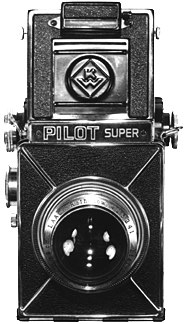
In the late thirties the “Pilot Super” was introduced. |
1933
The enlarger “Praxidos” is introduced at the Leipzig Fair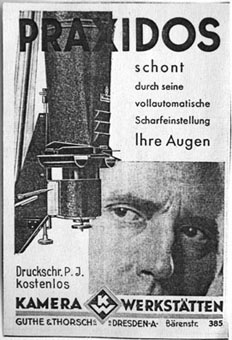
1937
Paul Guthe emigrates to Switzerland. As a jew he is not feeling safe in Germany any more.
1938
Benno Thorsch emigrates to the USA because of the same reason. He makes a deal with Charles A.Noble. Benno Thorsch buys Mr. Nobles Photocopy Company in Detroit/USA and Mr. Noble buys the KW in Dresden. Charles A.Noble realizes that the 35mm SLR-camera will become the camera of the future and he orderes the engineer Alois Hoheisel to design the Praktiflex.
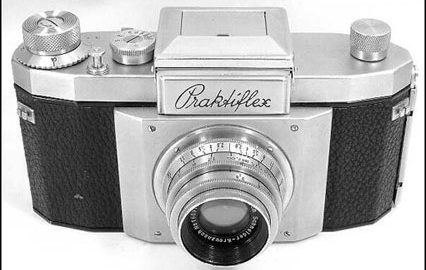
1939
The first “Praktiflex” 35mm SLR-camera is shown at the Leipzig fair, spring
1939.
The KW moves to the building of a former factory for drops and sweets and is now called:
Kamera-Werkstaetten Charles A. Noble
Bismarckstrasse 56
Dresden-Niedersedlitz
From 1939 untill the end of WWII in May 1945 the KW produces 11.000 Praktiflex cameras. As all other companies in Germany the KW is forced to produce more end more military items.
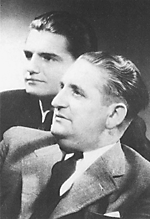
1945
The KW in Niedersedlitz is not hitten by the heavy bombing of Dresden in February 1945. The soviet administration in the Russian zone of eastern Germany demants the production of 25.000 Praktiflex cameras. Under great difficulties Charles A.Noble and his son John H.Noble take to Carl Zeiss in Jena for negotiating about the delivery of lenses for these cameras. Jena is still occupied by US-troops at that time. When they return to Dresden, Charles A. Noble and his son are arrested by the Russians and sent to prisoner-camps. In 1952 Charles A.Noble is sentenced to 7 years imprisonment but released soon after. His son John H.Noble was already in 1950 sentenced to 15 years imprisonment and deported to Russia. By the intervention of president Eisenhower he is released in 1955. Arround 1955 the communists spread the infamous lie that Mr. Noble from his house in Dresden-Weisser Hirsch has been leading the bomb attack of 13th February 1945 on Dresden.
1946
The factory is confiscated by the government and named:
VEB Kamera-Werkstaetten Niedersedlitz
(VEB = Volkseigener Betrieb = peobles own enterprice)
1949
Under the leadership of the clever young engineer Siegfried Boehm a new Praktica is developed from the Praktiflex. The camera receives a M42x1mm screwmount for the interchangable lenses. Through the following years the camera currently is modified to the different models of the Praktica FX.
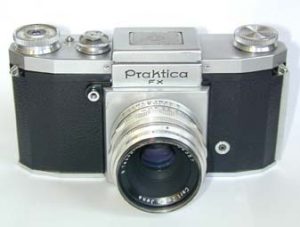
1952
The Praktina is introduced, a professional 35mm SLR-camera with bayonet-mount, interchangable lenses, viewfinders, motordrives and a 17m-magazine.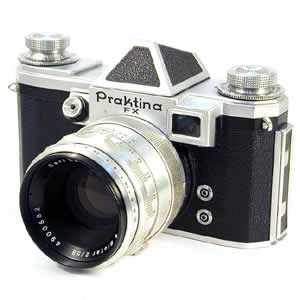
1953
The company has now more than 1000 employees end changes the name to:
VEB Kamera-Werk Niedersedlitz In general the factory is called KWN.
1955
The Praktica FX2 is introduced.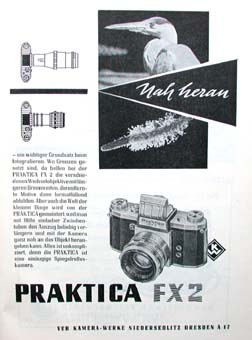
1956
The new professional 6x6cm “Praktisix” is introduced at the Photokina in Cologne.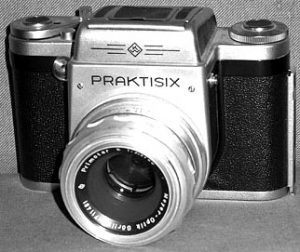
1959
Together with 4 other camera-factories the KWN is merged to:
VEB Kamera- und Kinowerke Dresden
The name and logo “KW” disappeares for ever. From 1964 the merged company is called:
VEB Pentacon Dresden
Many different models of the Praktica are produced untill 1990.
My own relation to the KWN From 1956 to 1957 I have been employed at the company. I worked as a toolsmaker and I also did work in the tempering plant where parts and tools were hardened. When the new medium-format SLR-camera Praktisix was developed and in a hurry finished to be shown at the Photokina 1956, I was asked to help in the developing-department to finish some small parts. The name of Mr.Noble I did hear first time when the communists spread the grazy story about his responsibility for the bombing of Dresden. 1956 my father returned efter 10 years as a prisoner of the communists. He told me that he under terrible circumstances in the prisoner-camp Muehlberg had met Mr.Noble, the former owner of the KW.
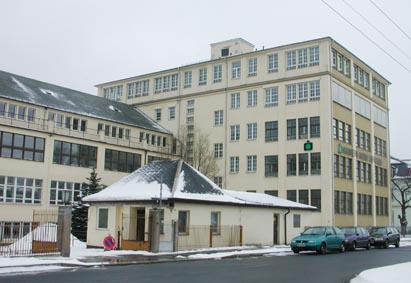
The premises still do exist at the same address. To day the “Noblex” panorama-camera is produced in the factory.
More detailed information about the history of the KW you will find in these 2 books:
- Herbert Blumtritt “Geschichte der Dresdner Fotoindustrie”
- Richard Hummel “Spiegelreflexkameras aus Dresden”
